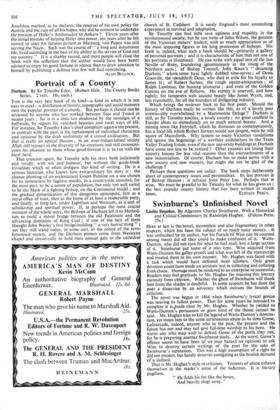Portrait of a County
Durham. By Sir Timothy Eden. (Robert Hale. The County Books Series. 2 vols. 18s. each.)
THIS is the very best book of its kind—a kind in which it is not easy to excel : a distillation of history, topography and social manners into the popular portrait of a county. But perhaps it should not be reviewed by anyone who has worked between Tees and Tweed in recent years ; for it is a little too shadowed by the nostalgia of a half-exile, by regrets for vanished beauties and rural ways of life. For instance, Sir Timothy Eden's chief complaint against the present, in contrast with the past, is the replacement of individual characters and opinions by the drab uniformity of a crowd civilisation. But that is really an optical illusion ; in an over-industrialised society Allah still rejoices in the diversity of his creatures and still communi- cates his pleasure to those whose good fortune it is to run with the local herd.
That criticism apart, Sir Timothy tells his story both judiciously and vividly, with wit and humour, but without the guide-book trivialities which so often disfigure this kind of writing. He is a serious historian who knows how extraordinary his story is : the chance planting of an ecclesiastical Count Palatine on a site chosen for its remoteness by fugitive monks, in a countryside unsuited, for the most part, to be a centre of population, but only too well suited to be the Mark of a fighting bishop, on the Continental model ; and the gradual domestication of this dangerous episcopate, first as a royal office of trust, then as the home of at least a respectable piety, and finally, at long last, under Lightfoot and Westcott, as a seat of scholarship and spiritual power. if, at perhaps the most crucial moment of the whole story, the Bishops of Durham left it to Method- ism to build a moral bridge between the old Palatinate and the advancing dominion of King Coal ; if one of the best of them thought John Wesley's first bridge-building" a very horrid thing " ; yet they still stand today, in some sort, at the centre of the revo- lutionised society, and the Durham pitmen come from Wesleyan chapel and circuit-rally to hold their annual gala in the cathedral church of St. Cuthbert. It is surely England's most astonishing experiment in survival and adaptation.
Sir Timothy can find little save ugliness and stupidity in the revolutionised society, but he can write of John Wilson, the greatest of the Victorian miners' leaders, with as much appreciation as of the most imposing figures in his long procession of bishops. His book is, indeed, what such a book should be—primarily a gallery of personal portraits ; and it is characteristic of him that not one of his portraits is ill-natured. He can write with equal zest of the last Neville of Raby, foundering ignominiously in the rising of the Northern earls ; of Bishop Tunstall, John Knox's "dreaming Durham," whom some have lightly dubbed time-server ; of Denis Granville, the spendthrift Dean, who died in exile for his loyalty to James 11; of Robert Surtees, the rough squire-antiquarian ; of Ralph Lambton, the hunting aristocrat ; and even of the Golden Canons on the eve of Reform. His enmity is reserved, and how rightly, for tamperers with ancient beauty like James Wyatt, and, less reasonably, for all the founders of disfiguring industry.
Which brings the reviewer back to his first point. Should the history of Durham really be written like this, as of a lovely past irretrievably overwhelmed by a Mamrnonite Deluge ? Durham is still, as Sir Timothy testifies, a lovely county ; no great coalfield in Europe abuts so immediately on so much natural beauty. And a mining town like Ferryhill, which he dismisses so contemptuously, has a local life which Robert Surtees would not despise, were he still squire of Mainsforth. Why lament so many Victorian vandalisms and ignore the beginnings of a worthier architecture in the Team Valley Trading Estate, even if the new university buildings at Durham have come too late to be noticed ? Other counties are losing their country houses for less vital reasons than the encroachments of a new industrialism. Of course, Durham has to make terms with a new society and new masters, but might she not be glad of the challenge ?
Perhaps these questions are unfair. The book stops deliberately short of contemporary issues and personalities. Its last portrait is of Bishop Henson : it refrains from Peter Lee. Perhaps that is wise. We must be grateful to Sir Timothy for what he has given us : the best popular county history that has been written in recent


































 Previous page
Previous page